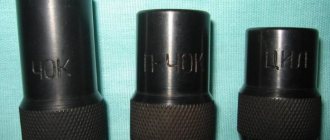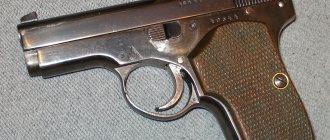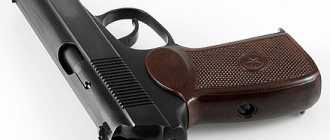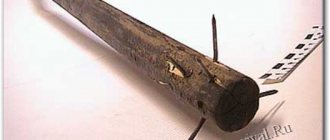Template:Ambox[[Category:Wikipedia:Articles without links to sources Error: wrong time ]]
This term has other meanings, see Dagger (meanings). Dagger
Dagger
(Arabic Template: Lang-ar2,
khanjar
see khanjar; presumably Turkic “kanjal” - 1. sheet of iron (metal) or 2.
kan
- blood and
heat
- flog, rip open) - cold weapon with short (up to 40 centimeters) with a straight or curved blade, sharpened on one or both sides.
According to GOST R No. 51500-99 - a dagger is a contact, bladed, piercing-cutting weapon with a short or medium straight or curved double-edged blade [1].
Most often the dagger is used for close combat, but there are varieties of the dagger with a weighted blade designed for throwing.
Story
Even in ancient times, warriors came to the conclusion that they needed some kind of short piercing weapon that they could constantly carry with them, and which was convenient for operating in situations where it was impossible to either swing a club or use a spear. The first daggers were made of wood and bone. It is likely that raw animal horns were originally used as daggers.
With the transition to the Metal Age, daggers began to be made from copper. Unlike wooden and bone ones, copper “swords” of the Mycenaean era already had a cutting edge, which somewhat expanded the possibilities of their use. However, they were still very small - with blades only 20-30 cm long - copper was not suitable for making longer weapons.
But even after copper and bronze were replaced by iron, small (with a blade of about 30 cm) “swords” were used by the Assyrians, Greeks and Macedonians.
Types
When writing this article, material was used from the Encyclopedic Dictionary of Brockhaus and Efron (1890-1907).
The eastern “kijar”, by the bend of its blade, is obviously an imitation of a cow’s horn, only in a flat form (there are, however, also round ones) and made of steel. This makes us think that the primitive dagger was nothing more than a real horn - an assumption further supported by the fact that in the deposits of the Paleolithic era (in France) branches of deer antlers were found, trimmed in the form of a dagger. Horns served as weapons in later eras; Thus, in India, back in the 19th century, a weapon made of two sharp horns, connected by their bases and covered in this place with a round metal plaque to protect the hand, was in use. This weapon was used in hand-to-hand combat to strike left and right.
During the Neolithic era of the Stone Age, in some European countries (especially Denmark), straight daggers were made from flint, sometimes even with a distinct handle, all from one piece of flint. Flint daggers were apparently the prototype of copper ones, many examples of which were found in Siberia.
In Western Europe, among the antiquities of the Bronze Age, daggers are almost never found; they were replaced by swords designed to stab rather than cut. However, the difference between a sword and a dagger is not always sharply expressed: there are both short swords and long daggers (for example, among Caucasians); The sword, however, is worn on the hip, and the dagger is worn in front (on the belt or behind the belt), but in this regard there are transitions. Typical daggers are characteristic primarily of the East, from India to Turkey; here they present the greatest variety of forms and names (kijar, bichvar, kuttar, scimitar, etc.). Some types of daggers originate from weapons with a concave blade (like a sickle); this was the kopis of the ancient Persians and then the Greeks, the kukri was the weapon of the Gurkhas in Nepal; This is also where the somewhat differently curved Turkish, Albanian and Persian scimitar comes from. Something between a dagger and a sword is represented by the Malay kris and various other weapons of the same type used by the Dayaks and other tribes of the Malay Archipelago.
Using Daggers
a)
black
b)
head
c)
stop
d)
blade
e)
golomen
f)
edge or full
g)
tip Damask dagger. Manufactured in 1840 at the Zlatoust plant.
As mentioned above, daggers were often used as a backup weapon for situations where the main weapon was difficult to use, for example due to its size. In this capacity, daggers were used in the armies of many countries.
In particular, the phalangist, having a piercing spear, needed some kind of backup weapon, the length of which did not matter. Moreover, fighting as part of the phalanx implied actions in extreme pressure.
The Greek peltasts, operating in loose formation and often without spears for hand-to-hand combat, were armed with “big swords” - with a blade up to 50 cm long. These were the daggers of the Persian “immortals” and Roman legionnaires.
Daggers used as offensive weapons were longer, but they were also very unsuitable for slashing. However, fighting in dense formations did not provide for the possibility of delivering such a blow - for it you need to have space to swing. Standing in close phalanx formation, blows could only be delivered straight forward.
Actions in a tight formation limited even the length of the weapon - it had to be easily removed from its sheath in the formation, not get tangled underfoot, and not cling to the equipment of other fighters. The “great sword” was as heavy as was practical and as long as possible. That is, it remained a dagger.
Daggers, as the main offensive weapon, were also used by many barbarian peoples who fought in the ranks. We can cite as an example the traditional weapon of the Saxons - “skramasax”, or simply “sax” - a dagger weighing 0.6-0.7 kg with a single-sided sharpened blade 45 cm long.
However, during the Middle Ages, daggers for a long time passed into the category of weapons of self-defense, since now, even if the infantry acted in close ranks, it was against cavalry, and the dagger was clearly weak against a horse. But the pikemen and crossbowmen needed some kind of backup weapon of light weight and dimensions suitable for carrying in the ranks.
Infantry combat daggers of the 14th and early 16th centuries were called cords or Landsknecht swords. In terms of blade length and weight, they were fully consistent with the “big swords” of antiquity. Moreover, the scope of their application was by no means limited to self-defense. In many cases, such as when the battle moved into the enemy camp, the pikemen threw their pikes and continued the attack with daggers.
The most common reason why a dagger could be worn was the frequent inability to get another bladed weapon. In comparison, even with a curved sword, making a dagger required less iron and less art, since the requirements for the strength of a piercing blade are significantly lower than for the strength of a chopping blade. For a blacksmith skilled in welding techniques, a dagger up to 40 cm long was one of the simplest products. On the other hand, carrying a dagger in conjunction with, say, a bow was not difficult and prudent. If only because it could be suitable for household needs.
The dagger was one of the most accessible types of weapons, and it was this circumstance that explained the fact that the mountaineers of the Caucasus in the 19th century carried a dagger even when paired with a saber. Turkey supplied the highlanders with sabers, as well as rifles (and even mountain cannons), while daggers and bows were their traditional weapons.
For Asia in general, the high role of daggers was an exception. Combat in dense formations was almost never practiced by Asian infantry, and accordingly, no special weapons were required for it. Therefore, although it was in Asia that daggers reached a remarkable variety of forms and, as a rule, were forged from Damascus and even damask steel, which significantly expanded their capabilities, their role on the battlefield was negligible. In Asia, daggers were used almost exclusively as civilian weapons.
In modern armed conflicts, combat daggers are used mainly as an auxiliary weapon designed to solve special tasks (neutralizing a sentry, eliminating the enemy in places where the use of firearms is not possible), or as a “weapon of last chance.” A typical example of a modern combat dagger can be considered the Applegate-Fairbairn Combat II.
Specifications
| Characteristic | Meaning |
| Blade type | Double-Edged Dagger |
| Blade length (mm) | 325 |
| Blade width (mm) | 36 |
| Butt thickness (mm) | 5,5 |
| Steel | 50Х14МФ |
| Handle | Wood, metal, riveted assembly |
| Handle length (mm) | 140 |
| Overall Length (mm) | 465 |
National, traditional and legendary daggers
- The baselard
is a popular medieval Swiss dagger with a narrow, straight, double-edged blade. - Bebut
is a Caucasian dagger with a curved blade, single-sided sharpening, without a guard. It was in service with the Russian army at the beginning of the 20th century. - Daga
is a dagger for the left hand when fencing with a sword, which became widespread in Europe in the 15th-17th centuries. - Jambia
is an Arab dagger with a wide curved blade without a guard. A mandatory accessory for a man's suit in Yemen. - Dirk
is a Scottish dagger, has a long straight blade with a one-and-a-half sharpening, and a handle without a cross. - Shoapozhnik
is a Slavic dagger with a tetrahedral, double-edged curved blade without a guard, worn behind the top of the boot. - Kama
is a bladed weapon, a dagger, used by the peoples of the Caucasus, Transcaucasia and the Middle East. - Katar
is an Indian stabbed dagger with an H-shaped handle. - Quilon
is a medieval dagger in the form of a smaller copy of a knight's sword and worn complete with the same real sword. - Kogai
is a Japanese multi-purpose knife-dagger in the shape of a cylindrical hairpin, located in a special slot on the scabbard of swords. - Cord
is a knife with a straight, relatively narrow blade, with a pattern on the guard. - Kris
is an Indonesian knife or dagger with an asymmetrical shape. The most famous are the wavy varieties of kris. - Misericordia
is a dagger with a narrow blade section for penetration between the joints of knightly armor. - A push-dagger
is a small, usually double-edged dagger with a transverse T-shaped handle. - Rondel
is a long dagger with a flat round guard and the same pommel, and with a narrow, stiletto-shaped blade. - Sai
is a Japanese stiletto with a trident-like handle. - A skin doo
is a small Scottish dagger worn behind a golf garter. - Scramasax
- ancient Germanic dagger - Tanto
- Japanese dagger - Khanjar
is a curved dagger, a mandatory item in the traditional costume of the Arabs of Oman. - The Cinqueda
is an Italian Renaissance dagger. - The Fairbairn-Sykes fighting knife
is the most famous dagger of World War II.
Description of the KKV dagger from Kizlyar
The blade is double-edged, classic dagger shape, tapering begins after the first third of the length. It is diamond-shaped in cross section. The blade has four narrow fullers, and on the heel there is an artistic engraving with the abbreviation KKV on one side and ZOF (Zlatoust Arms Factory) on the other. The slopes to the cutting edge are straight.
The handle is flat, made of two wooden dies riveted onto the shank. Its shape is typical for daggers of the Caucasian type - an I-beam with a rounded pommel of the handle. Brass bolster (silver, cupronickel, Damascus steel - depending on the model) in the form of a ring frame. An ornament is applied to it using the embossing method, and it is secured with a through rivet with a large grooved head. The pommel has a similar rivet, under which is placed a wide oval washer made of the same material as the bolster. On the back of the handle, the rivet heads are flush and have the “K” logo stamped on them.
The scabbard is wooden, covered with black genuine leather. The lower frame is metal, decorated with a convex ornament (chasing) and has a pointed drop-shaped end at its end.
The mouth is also richly decorated with embossing. A clamp with a ring for a sword belt is attached to it.
Advantages and disadvantages
The dagger is beautiful, in general terms it really looks like the legendary weapon of the Caucasian highlanders and Kuban Cossacks. If you are not overly strict, then you cannot find a better gift for a man. But, since “the devil is in the details,” it is worth pointing out the inconsistencies with the original - the KKV dagger of the 1904 model.
- The narrowing of the blade, the shape of which was approved by the Supreme Decree, begins almost from the guard. To be precise - at a distance of 9/16 inches. In the Kizlyar replica it begins after the first third of the length.
- The original blade has two fullers, and the slopes to the cutting edge are concave.
- The replica's handle is missing the third rivet, the so-called button.
- The lower frame of the replica scabbard ends with a pointed knob. In the original it is spherical.
KKV dagger from Kizlyar (photo)
Application
- The Cossack dagger KKV Kizlyar is a bladed weapon. Its wearing is allowed to people who have a license or certificate of a registered Cossack.
- Can be used as a reward weapon, souvenir, gift.
Varieties
There are four types of KKV dagger models available. They differ in the material of the scabbard and rivets on the handle.
- KKV brass.
- KKV cupronickel.
- KKV silver.
- KKV Damascus steel.
The KKV Kizlyar dagger on the Internet has a lot of drawings for the possibility of recreating.










